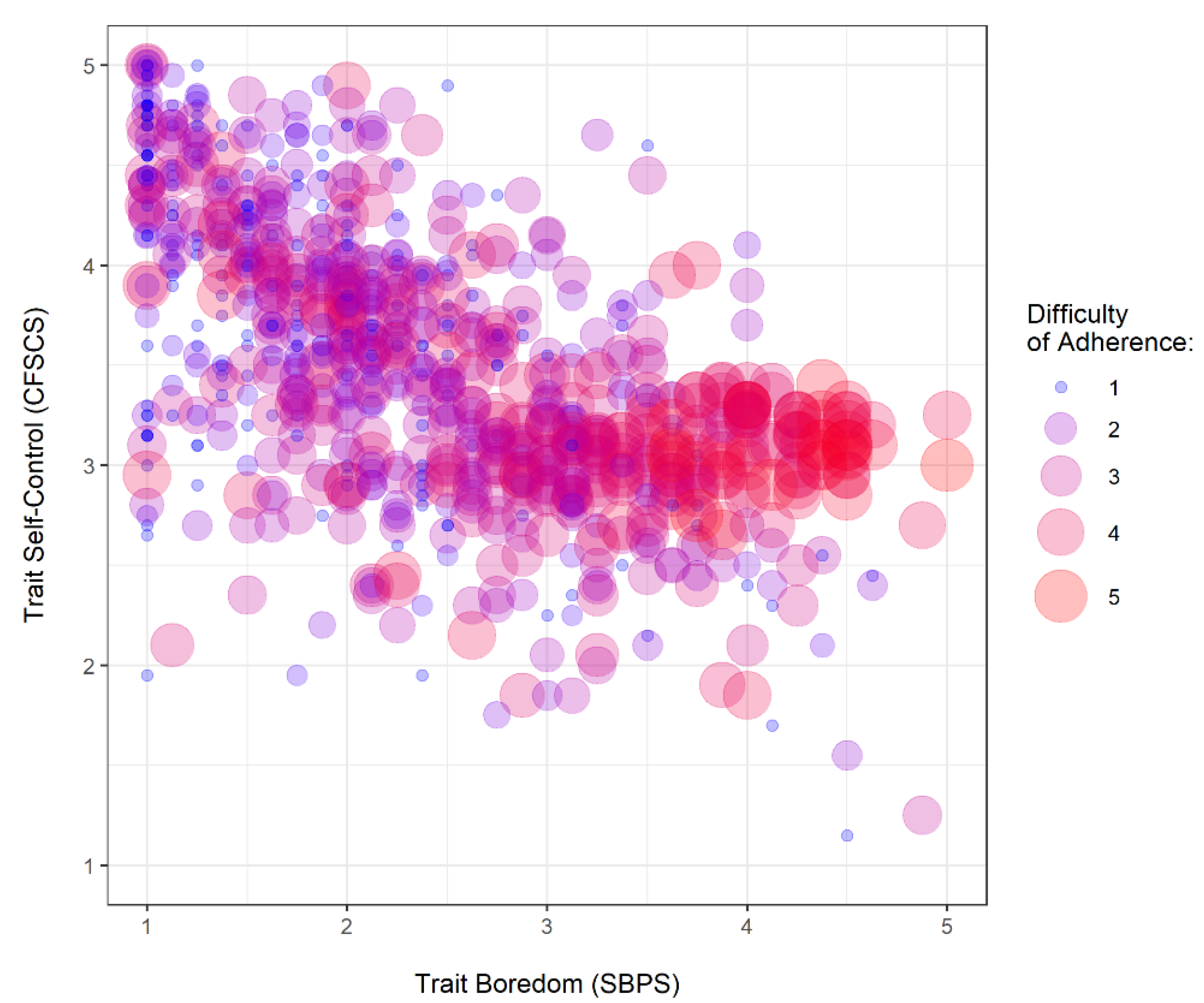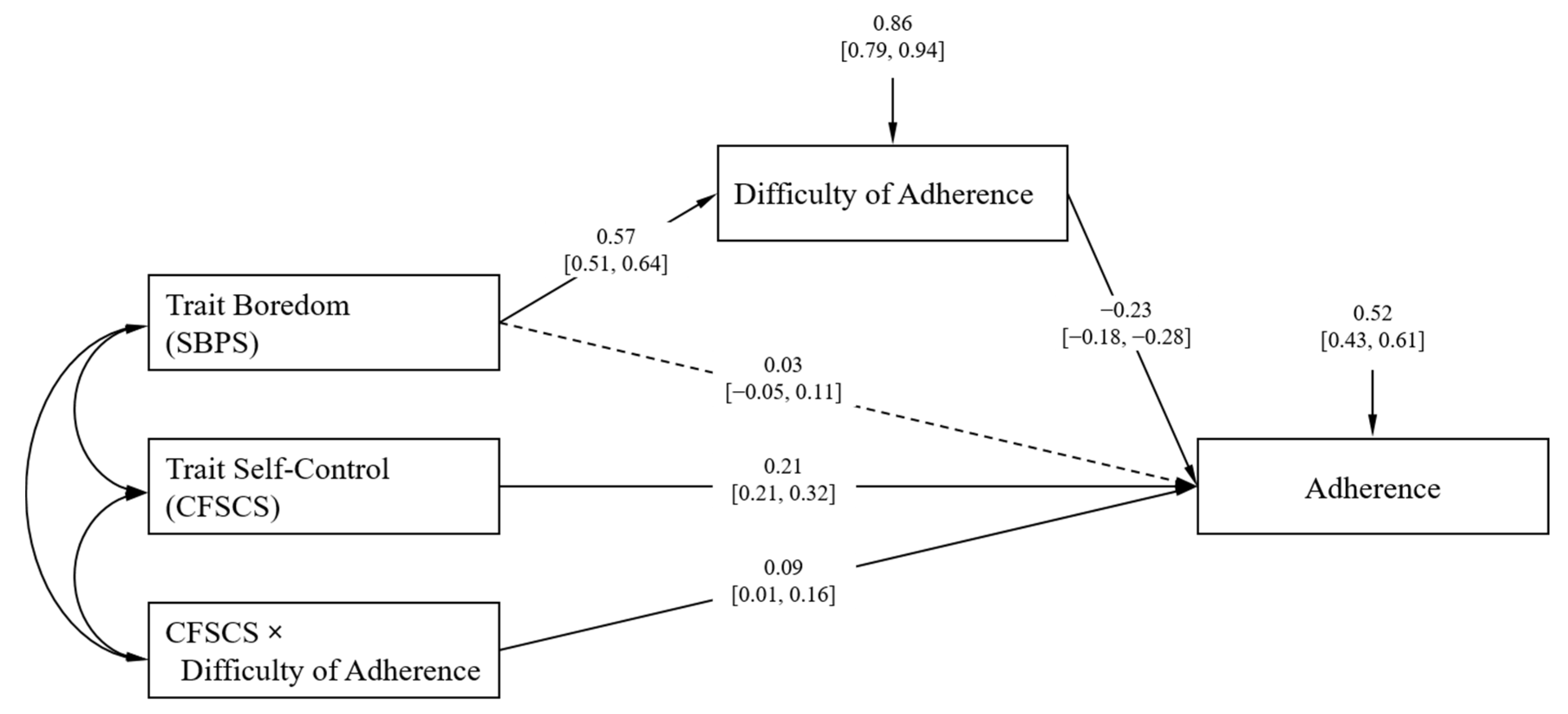High Boredom Proneness and Low Trait Self-Control Impair Adherence to Social Distancing Guidelines during the COVID-19 Pandemic
Abstract
1. Introduction
1.1. The Impact of Boredom on Goal-Directed Behavior
1.2. The Role of Self-Control in Goal-Directed Behavior
1.3. The Present Study
2. Methods and Participants
2.1. Procedure
2.2. Statistical Approach
3. Results
4. Discussion
Implications for the COVID-19 Pandemic
5. Conclusions
Author Contributions
Funding
Conflicts of Interest
References
- WHO. WHO Announces COVID-19 Outbreak a Pandemic. 2020. Available online: https://www.euro.who.int/en/health-topics/health-emergencies/coronavirus-covid-19/news/news/2020/3/who-announces-covid-19-outbreak-a-pandemic (accessed on 27 July 2020).
- Dong, E.; Du, H.; Gardner, L. An interactive web-based dashboard to track COVID-19 in real time. Lancet Infect. Dis. 2020. [Google Scholar] [CrossRef]
- Anderson, R.M.; Heesterbeek, H.; Klinkenberg, D.; Hollingsworth, T.D. How will country-based mitigation measures influence the course of the COVID-19 epidemic? Lancet 2020, 395, 931–934. [Google Scholar] [CrossRef]
- Prem, K.; Liu, Y.; Russell, T.W.; Kucharski, A.J.; Eggo, R.M.; Davies, N. The effect of control strategies to reduce social mixing on outcomes of the COVID-19 epidemic in Wuhan, China: A modelling study. Lancet Public Health 2020. [Google Scholar] [CrossRef]
- Kucharski, A.J.; Russell, T.W.; Diamond, C.; Liu, Y.; Edmunds, J.; Funk, S. Early dynamics of transmission and control of COVID-19: A mathematical modelling study. Lancet Infect. Dis. 2020. [Google Scholar] [CrossRef]
- Park, S.-C.; Park, Y.C. Mental health care measures in response to the 2019 novel coronavirus outbreak in Korea. Psychiat. Investig. 2020, 17, 85–86. [Google Scholar] [CrossRef] [PubMed]
- Brooks, S.K.; Webster, R.K.; Smith, L.E.; Woodland, L.; Wessely, S.; Greenberg, N. The psychological impact of quarantine and how to reduce it: Rapid review of the evidence. Lancet 2020, 395, 912–920. [Google Scholar] [CrossRef]
- Evaluating COVID-19 Public Health Messaging in Italy: Self-reported Compliance and Growing Mental Health Concerns. Available online: https://j.mp/39btyT2 (accessed on 27 July 2020).
- Lunn, P.; Belton, C.; Lavin, C.; McGowan, F.; Timmons, S.; Robertson, D. Using behavioural science to help fight the coronavirus: A rapid narrative review. JBPA 2020. [Google Scholar] [CrossRef]
- Duckworth, A.L. The significance of self-control. Proc. Natl. Acad. Sci. USA 2011, 108, 2639–2640. [Google Scholar] [CrossRef]
- Wolff, W.; Martarelli, C.S. Bored into depletion? Towards a tentative integration of perceived self-control exertion and boredom as guiding signals for goal-directed behavior. Perspect. Psychol. Sci. 2020. [Google Scholar] [CrossRef]
- Harris, M.B. Correlates and characteristics of boredom proneness and boredom. J. Appl. Soc. Psychol. 2000, 30, 576–598. [Google Scholar] [CrossRef]
- Westgate, E.C.; Wilson, T.D. Boring thoughts and bored minds: The MAC model of boredom and cognitive engagement. Psychol. Rev. 2018, 125, 689–713. [Google Scholar] [CrossRef] [PubMed]
- Eastwood, J.D.; Frischen, A.; Fenske, M.J.; Smilek, D. The unengaged mind: Defining boredom in terms of attention. Perspect. Psychol. Sci. 2012, 7, 482–495. [Google Scholar] [CrossRef]
- Bench, S.W.; Lench, H.C. Boredom as a seeking state: Boredom prompts the pursuit of novel (even negative) experiences. Emotion 2019, 19, 242–254. [Google Scholar] [CrossRef]
- Shenhav, A.; Botvinick, M.M.; Cohen, J.D. The expected value of control: An integrative theory of anterior cingulate cortex function. Neuron 2013, 79, 217–240. [Google Scholar] [CrossRef] [PubMed]
- Wolff, W.; Sieber, V.; Bieleke, M.; Englert, C. Task duration and task order do not matter: No effect on self-control performance. Psychol. Res. 2019. [Google Scholar] [CrossRef] [PubMed]
- Shenhav, A.; Musslick, S.; Lieder, F.; Kool, W.; Griffiths, T.L.; Cohen, J.D.; Botvinick, M.M. Toward a Rational and Mechanistic Account of Mental Effort. Annu. Rev. Neurosci. 2017, 40, 99–124. [Google Scholar] [CrossRef]
- Kurzban, R.; Duckworth, A.; Kable, J.W.; Myers, J. An opportunity cost model of subjective effort and task performance. Behav. Brain Sci. 2013, 36. [Google Scholar] [CrossRef]
- Wolff, W.; Schüler, J.; Hofstetter, J.; Baumann, L.; Wolf, L.; Dettmers, C. Trait self-control outperforms trait fatigue in predicting MS patients’ cortical and perceptual responses to an exhaustive task. Neural. Plast. 2019. [Google Scholar] [CrossRef]
- Schönbrodt, F.D.; Perugini, M. At what sample size do correlations stabilize? J. Res. Pers. 2013, 47, 609–612. [Google Scholar] [CrossRef]
- Oppenheimer, D.M.; Meyvis, T.; Davidenko, N. Instructional manipulation checks: Detecting satisficing to increase statistical power. J. Exp. Soc. Psychol. 2009, 45, 867–872. [Google Scholar] [CrossRef]
- Struk, A.A.; Carriere, J.S.A.; Cheyne, J.A.; Danckert, J. A short boredom proneness scale: Development and psychometric properties. Assessment 2017, 24, 346–359. [Google Scholar] [CrossRef]
- Hoyle, R.H.; Davisson, E.K. Varieties of self-control and their personality correlates. In Handbook of Self-regulation: Research, Theory, and Applications, 3rd ed.; Vohs, K.D., Baumeister, R.F., Eds.; Guilford Press: New York, NY, USA, 2016; Volume 3, pp. 396–413. [Google Scholar]
- MacCallum, R.C.; Austin, J.T. Applications of structural equation modeling in psychological research. Annu. Rev. Psychol. 2000. [Google Scholar] [CrossRef] [PubMed]
- Goetz, T.; Bieleke, M.; Gogol, K.; van Tartwijk, J.; Mainhard, T.; Lipnevich, A.A.; Pekrun, R. Getting along and feeling good: Reciprocal associations between student-teacher relationship quality and students’ emotions. Learn. Instr. in press.
- Individual Differences in If-then Planning: Insights From the Development and Application of the If-then Planning Sale (ITPS). Available online: https://psyarxiv.com/2efnv/ (accessed on 27 July 2020).
- Boredom Makes It Difficult, but It Helps to Have a Plan: Investigating Adherence to Social Distancing Guidelines during the COVID-19 Pandemic. Available online: https://psyarxiv.com/enzbv/ (accessed on 27 July 2020).
- Dalal, D.K.; Zickar, M.J. Some common myths about centering predictor variables in moderated multiple regression and polynomial regression. Organ. Res. 2012, 339–362. [Google Scholar] [CrossRef]
- R: A Language and Environment for Statistical Computing. Available online: https://cran.r-project.org/ (accessed on 27 July 2020).
- Muthén, L.K.; Muthén, B.O. Mplus User’s Guide, 8th ed.; Muthén & Muthén: Los Angeles, CA, USA, 2017. [Google Scholar]
- Kline, R.B. Principles and Practice of Structural Equation Modeling, 4th ed.; Guilford publications: New York, NY, USA, 2015. [Google Scholar]
- Mugon, J.; Struk, A.; Danckert, J. A failure to launch: Regulatory modes and boredom proneness. Front. Psychol. 2018. [Google Scholar] [CrossRef] [PubMed]
- Chang, S.L.; Harding, N.; Zachreson, C.; Cliff, O.M.; Prokopenko, M. Modelling Transmission and Control of the COVID-19 Pandemic in Australia. Available online: https://arxiv.org/pdf/2003.10218.pdf (accessed on 27 July 2020).
- Nett, U.E.; Goetz, T.; Hall, N.C. Coping with boredom in school: An experience sampling perspective. Contemp. Educ. Psychol. 2011, 36, 49–59. [Google Scholar] [CrossRef]
- Friese, M.; Frankenbach, J.; Job, V.; Loschelder, D.D. Does self-control training improve self-control? A meta-analysis. Perspect. Psychol. Sci. 2017, 12, 1077–1099. [Google Scholar] [CrossRef] [PubMed]
- Gollwitzer, P.M. Implementation intentions: Strong effects of simple plans. Am. Psychol. 1999, 54, 493–503. [Google Scholar] [CrossRef]
- Gollwitzer, A.; Martel, C.; Marshall, J.; Höhs, J.; Bargh, J.A. Connecting Self-reported Social Distancing to Real-world Behavior at the Individual and US State Level. Available online: https://doi.org/10.31234/osf.io/kvnwp (accessed on 27 July 2020).
- Martarelli, C.S.; Wolff, W. Too bored to bother? Boredom as a potential threat to the efficacy of pandemic containment measures. Humanit. Soc. Sci. Commun. 2020, 7, 1–5. [Google Scholar] [CrossRef]
- Harper, C.A.; Satchell, L.P.; Fido, D.; Latzman, R.D. Functional fear predicts public health compliance in the COVID-19 pandemic. Int. J. Ment. Health Addict. 2020. [Google Scholar] [CrossRef]
- Predictors of Attitudes and Misperceptions about COVID-19 in Canada, the U.K., and the U.S.A. Available online: https://doi.org/10.31234/osf.io/zhjkp (accessed on 27 July 2020).
- Van Bavel, J.J.; Baicker, K.; Boggio, P.S.; Capraro, V.; Cichocka, A.; Cikara, M.; Drury, J. Using social and behavioural science to support COVID-19 pandemic response. Nat. Hum. Behav. 2020. [Google Scholar] [CrossRef]


| Variable | M | SD | 1 | 2 | 3 | 4 |
|---|---|---|---|---|---|---|
| 1. Adherence | 4.58 | 0.79 | - | - | - | - |
| 2. Difficulty of adherence | 2.31 | 1.09 | −0.36 *** | - | - | - |
| [−0.42, −0.30] | ||||||
| 3. Diagnosed with COVID-19 or quarantined because of it | 0.06 | 0.24 | −0.16 *** | 0.18 *** | - | - |
| [−0.22, −0.09] | [0.12, 0.24] | |||||
| 4. Trait boredom (SBPS) | 2.40 | 1.00 | −0.24 *** | 0.52 *** | 0.23 *** | - |
| [−0.30, −0.18] | [0.47, 0.57] | [0.16, 0.29] | ||||
| 5. Trait self-control (CFSCS) | 3.53 | 0.71 | 0.24 *** | −0.31*** | −0.10 *** | −0.61 *** |
| [0.18, 0.30] | [−0.37, −0.25] | [−0.16, −0.03] | [−0.65, −0.57] |
| Variable | Dependent Variable | ||||
|---|---|---|---|---|---|
| Adherence | Difficulty | Adherence | Adherence | Adherence | |
| Intercept | 0.00 (0.03) | −0.00 (0.03) | 0.00 (0.02) | 0.02 (0.03) | 0.01 (0.03) |
| Trait Boredom (SBPS) | −0.12 *** (0.03) | 0.58 *** (0.04) | 0.02 (0.03) | 0.03 (0.03) | 0.02 (0.04) |
| Trait Self-Control (CFSCS) | 0.17 *** (0.03) | 0.03 (0.06) | 0.17 *** (0.04) | 0.21 *** (0.05) | 0.18 *** (0.04) |
| Difficulty of Adherence | - | - | −0.24 *** (0.03) | −0.23 *** (0.03) | −0.23 *** (0.03) |
| CFSCS × Difficulty | - | - | - | 0.08 * (0.04) | - |
| SBPS × Difficulty | - | - | - | - | −0.01 (0.02) |
| R2 | 0.07 | 0.27 | 0.15 | 0.15 | 0.15 |
| Adj. R2 | 0.07 | 0.27 | 0.15 | 0.15 | 0.15 |
| N | 895 | 895 | 895 | 895 | 895 |
© 2020 by the authors. Licensee MDPI, Basel, Switzerland. This article is an open access article distributed under the terms and conditions of the Creative Commons Attribution (CC BY) license (http://creativecommons.org/licenses/by/4.0/).
Share and Cite
Wolff, W.; Martarelli, C.S.; Schüler, J.; Bieleke, M. High Boredom Proneness and Low Trait Self-Control Impair Adherence to Social Distancing Guidelines during the COVID-19 Pandemic. Int. J. Environ. Res. Public Health 2020, 17, 5420. https://doi.org/10.3390/ijerph17155420
Wolff W, Martarelli CS, Schüler J, Bieleke M. High Boredom Proneness and Low Trait Self-Control Impair Adherence to Social Distancing Guidelines during the COVID-19 Pandemic. International Journal of Environmental Research and Public Health. 2020; 17(15):5420. https://doi.org/10.3390/ijerph17155420
Chicago/Turabian StyleWolff, Wanja, Corinna S. Martarelli, Julia Schüler, and Maik Bieleke. 2020. "High Boredom Proneness and Low Trait Self-Control Impair Adherence to Social Distancing Guidelines during the COVID-19 Pandemic" International Journal of Environmental Research and Public Health 17, no. 15: 5420. https://doi.org/10.3390/ijerph17155420
APA StyleWolff, W., Martarelli, C. S., Schüler, J., & Bieleke, M. (2020). High Boredom Proneness and Low Trait Self-Control Impair Adherence to Social Distancing Guidelines during the COVID-19 Pandemic. International Journal of Environmental Research and Public Health, 17(15), 5420. https://doi.org/10.3390/ijerph17155420





